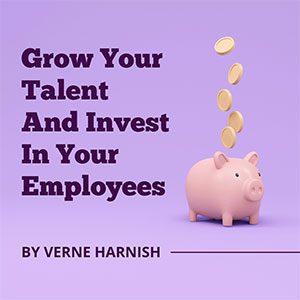 Grow Your Talent And Invest In Your Employees
Grow Your Talent And Invest In Your Employees
Verne Harnish
In order to keep your company competitive and your people loyal, you must grow them through education and coaching. Based on exhaustive research done by Laurie Bassi, co-author of “Good Company: Business Success in the Worthiness Era,” this investment in people is the single biggest predictor of a company’s ability to beat its direct competitors and the overall market.
Onboarding: Getting The First Impression Right
One of the biggest opportunities to grow and align your people is when they first start working for you. Their initial weeks on the job represent a unique chance to create connection and deeply ingrain a company’s DNA into new people. However, few companies make proper use of this opportunity. Instead, the first days on the job often feel more like waterboarding than onboarding: no desk, no computer, and no phone; the new boss is traveling; and the first assignment is shadowing an unenthusiastic colleague for two weeks.
Onboarding needs to be a celebration, not paperwork. It should create emotional connections between the new recruit and team members.
Formal Orientation
To properly inculcate a new employee (bring them into the culture), structure a formal orientation process. It’s most effective when organized around doing real work while emphasizing the company’s values and purpose.
Boston-based global services company Sapient had one of our favorite orientation processes: It was a five-day “boot camp.” All new recruits would spend a week working on internal projects, and, as they worked on these projects, one core value was reinforced each day. By the end of the week, everyone understood in a real way the cultural and strategic approach Sapient preferred for projects.
Sapient’s recruitment team found that new recruits who went through the boot camp could hit the ground running at near 100% field-ready alignment, whereas before the orientation process was introduced, they had normally needed a frustrating six-month ramp-up period.
People are exceptionally positive, receptive, and willing to learn in this phase. So be careful about the kind of induction program you put in front of your “hatchlings.” Dumping a 200-page binder of company policies on their desks is probably not sending the right message.
Growing People Through Coaching
As Google’s people analytics team discovered, one-on-one coaching is the No. 1 factor linked to great management. The best framework for coaching is Ken Blanchard and Paul Hersey’s concept of situational leadership. It guides leaders on how to mix the right amount of direction and support, depending on the competency and confidence of the person being coached.
Based on this model, managers can move employees through a development cycle that reduces the step-by-step need for direction and support until a task can be fully delegated.
As with any tool, this model requires a rhythm of use to make it effective. This is where regularly scheduled one-on-one coaching conversations are helpful and can replace the dreaded quarterly or annual performance reviews. Set a specific day each week or month to touch base, and stick to it. Frequent canceling sends a message that it’s not important. If it is monthly, an hour is appropriate; if it’s weekly, then budget 20–30 minutes.
Use these conversations to review individual key performance indicators and priorities. Recognize good performance, analyze underperformance, and discuss activities needed to get back on track. Ask questions to put the focus on the process rather than lamenting results. Also give feedback on adherence to core values and, if necessary, develop strategies to correct behavior. Don’t hold back; timely feedback is the most effective. It is easier to digest and prevents the formation of bad habits.
In order to grow people, you must expose them to different experiences. Regularly modify an employee’s tasks and responsibilities to present new challenges. This is how experience-learning happens, especially when these challenges allow people to play to their strengths. Regularly question each employee’s task list in your coaching conversations and search for opportunities to refocus activities on areas that the person is naturally drawn to but that, at the same time, represent a challenge.
Frame these development conversations by sharing your view about where the markets, industry, and company are heading and how your employee’s plans, aspirations, and dreams fit into this bigger picture.
In his book, “The Weekly Coaching Conversation,” Brian Souza notes, “Great coaches consistently get the most out of their people because they consistently put the most into their people.” Managing people is difficult because people are complex. In today’s high-pressure environments, it is very easy to get caught up in the fight for results and to forget about the complex human beings who are needed to produce them. That’s why it is good to remind ourselves that in business and in life, the journey, not the destination, is the reward. To quote Souza, as he beautifully describes the deeper purpose of coaching: “When all is said and done and we’ve completed this journey we call life, what will matter most is not what we have achieved — but rather, who we have become.”





